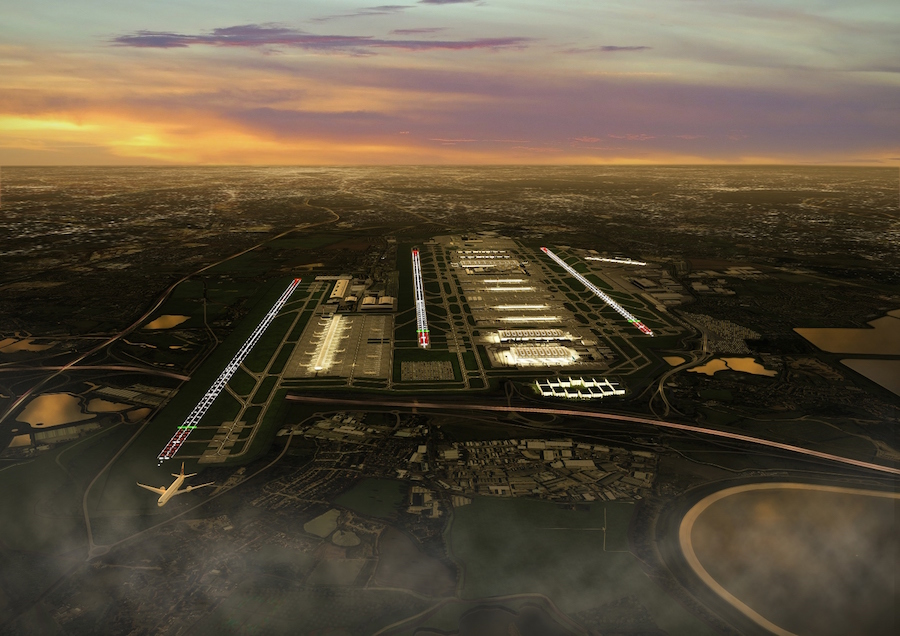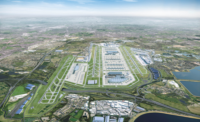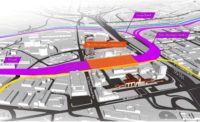The private owner and operator of one of the world’s oldest and busiest international airports, London Heathrow, plans to spend $19.4 billion on a third runway and new terminal facilities in what officials believe will be Europe’s largest privately financed airport project.
Located 25 kilometers from the city, Heathrow has grown piecemeal for over 85 years and now is operating close to capacity. The owner, Heathrow Airport Ltd. (HAL), says it will soon sign key design and management contracts to get the job moving. The project needs ratification by Parliament, a possibility next year, along with routine permitting. HAL says it will invest some $60 million by the end of 2017 and $560 million before construction is due to begin in 2021.
Heathrow is owned by five companies, led by Spanish contractor Ferrovial S.A. Other investors include the government wealth funds of China, Singapore and Qatar.
HAL estimates its required investment at $19.4 billion, including $5.8 billion for terminals and $241 million for highway tunnels. But including external transportation improvements, the overall cost could be much more. HAL expects 50% of airport visitors to use public transportation by 2030, and Transport for London believes the cost of boosting infrastructure capacity for that goal could reach up to $25 billion.
HAL’s development director, Phil Wilbraham, says 95% of the project’s investment will be made within the British supply chain. Contracts to prepare the project will be signed soon, he adds.
Among those in line for contracts are the design firms Arup Group Ltd. and CH2M Ltd., the contractor MACE Group plc. and project manager Turner & Townsend plc. They were all selected as HAL’s program partners this March. Their conditional appointment was followed in July by London-based Grimshaw Architects, joining as lead concept designer.
HAL’s plan calls for a new 3,500-meter-long runway about 1 km north of the nearer of the two existing runways. With passenger terminals and the other planned aviation facilities, the project will increase the airport’s current 1,227-hectare footprint by 46%. About 800 homes in two villages will be torn down to make room, and another 3,750 just outside the expansion zone likely will become commercially worthless.
The expanded footprint also incorporates sections of the M4 motorway and London’s beltway, the M25, which is one the country’s busiest routes. HAL had planned to move the highways into a 600-m-long cut-and-cover tunnel. But, recently, a less costly and disruptive plan has emerged to eliminate the 82-m-wide, 14-lane tunnel by gently ramping the runway over the existing motorways.
Years of Controversy
After years of agonizing debate, the government’s green light is broadly welcomed by corporations, trade unions, politicians and construction executives. The government’s decision “is a positive statement of intent that the country is open for business and a further indication of its commitment to developing the infrastructure we need to be a world-leading economy,” according to Nick Roberts, U.K. and Europe CEO of the design firm W.S. Atkins plc.
But opponents fear the environmental implications. The expansion “will be devastating for air quality across London,” says the city’s mayor, Sadiq Khan, who will continue to oppose the scheme. The environmental group Friends of the Earth claims a third runway “would be the single biggest threat to the U.K. hitting its climate-change targets.”
The airport started out in the early 1930s as a grass runway near the ancient village of Heath Row. The government expanded the aerodrome for military use during World War II, handing it over for commercial aviation in 1946.
In the past decade, HAL has invested $13.6 billion at the airport, including two new terminals. Until Terminal One closed in 2015, Heathrow’s five terminals totalled nearly 600,000 sq m and was at capacity for handling 75 million passengers a year.
As the airport became increasingly congested, the government in 2003 set out proposals for a third runway. Six years later, the Labour government then in power decided to go ahead with expansion, including a new runway and terminal. Then valued at $11 billion, the project was due for completion by last year.
But the main opposition Conservative Party vowed to continue fighting the scheme. When it got into power in 2010, it halted the scheme. But with Heathrow at 99% runway capacity, pressure mounted on the new government to come up with an aviation plan for southeast England.
So, in September 2012, the government created an airport commission to produce that plan, led by Howard Davies, now chairman of the Royal Bank of Scotland.
Heathrow’s most serious rival was the smaller, more rural Gatwick airport, located about 50 km south of London. A proposal for an entirely new airport in the Thames Estuary, designed by architect Norman Foster and backed by the then London mayor, Boris Johnson, was quickly ruled out. Requiring the closure of Heathrow and major new transportation links to London, some 55 km away, the project would cost $150 billion, according to the commission.
When the commission finally reported in July 2015, its main recommendation put the Conservative government in a spot. Despite having vowed not to expand Heathrow, the government last month approved the scheme, causing the local Conservative member of Parliament to resign his seat.
Expanding Gatwick airport “would have boosted our economy without causing these huge air and noise pollution problems, and it could be built quicker and cheaper,” says Gatwick’s chief executive, Stewart Wingate. His company is ready to expand since “the challenges facing Heathrow have not changed,” he adds.




